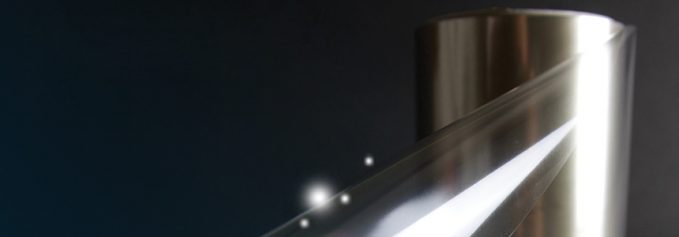
By Cassandra Balentine
Antimicrobial coatings continue to gain ground in the graphic arts, with current popularity mainly driven by the coronavirus crisis. The chemistry has existed for some time. These speciality coatings are developed with properties to help minimize the risk of microbial growth between surface cleanings.
Antimicrobial coatings are designed to impede bacterial or viral pathogens from propagating on a coated surface. Terry Amerine, VP, sales and marketing, Polymeric Group, says this is achieved by formulating the coating with specific active ingredients.
Similarly, Neil Gillespie, VP of technology, Dunmore, notes that antimicrobial technology is a surface coating that reduces the growth of bacteria, fungi, and mold. For example, Dunmore Dun-Shield antimicrobial coating utilizes silver ion technology. “Silver ions release on the surface of the film, which damages the cell wall of microorganisms. As a result there is a loss of function of the microorganism and it inhibits the ability for the microorganism to reproduce,” he explains. In addition to silver, zinc and copper are other effective elements used in antimicrobial coatings.
Above: Dunmore specializes in adding functional coatings to various film substrates.
The COVID Effect
During a worldwide pandemic, all industries are finding ways to slow the spread of bacterial growth, minimize the risk of contamination, and improve safety of employees and customers.
The role of antimicrobial coatings is increasingly popular as businesses look for ways to promote employee and customer safety. “To the best of our knowledge, antimicrobial films and coatings have not been widely adopted for printing applications. Printing companies are beginning to use antimicrobial films as overlaminates for their graphics products,” shares Gillespie.
Specialty liquid coatings are generally applied as a flood topcoat over the printed substrate. The pathogens must come in contact with the coating in order for them to be effective. “The most common application methods were spray or roller coating or via the printing—screen, offset, or flexographic—process as the last item down,” shares Amerine.
Due to COVID-19, the usage of antimicrobial products has shifted dramatically. “Companies are looking for antimicrobial for high-traffic, surface applications,” says Gillespie.
Amerine also sees a significant increase in the use and interest in antimicrobial coatings due to COVID-19. However, he points out that having efficacy against a virus is different than e.coli or staph and other bacterial pathogens. The biggest trend for antimicrobial coatings is the drive to achieve efficacy against SARS-CoV-2, the COVID-19 causing virus. “Any coating that is used and states it is effective against COVID-19 requires extensive testing and registration with the EPA.”
Common Applications
Nearly any substrate benefits from a coating with antimicrobial characteristics. These coatings are applied via spray, roller coaters, or as part of the printing process.
“The coating must provide adhesion and meet all of the other requirements for the end product in addition to being antimicrobial,” comments Amerine.
In many instances, antimicrobial treatments come in the form of additives that can be added to another coating solution to provide the base benefits of the coating and antimicrobial properties.
Gillespie says adding the active antimicrobial material to the coating concentrates more activity to the surface where it is needed. “This not only improves the antimicrobial activity but reduces cost since the additive is not lost in the bulk of the item. Secondly, other functionality can be included to the coating to enhance the overall performance of the product.”
Amerine argues that to achieve antimicrobial properties without the use of an additive a surface morphology—or texture—essentially pierces the outer membrane of the pathogen. He says a common approach is to have a coating with the additive that provides the antimicrobial properties. This allows the coating to provide other functionality like scratch and chemical resistance, which is a major advantage of this approach. “It enables us to take the vast catalog of our current functional coatings and make them antimicrobial as well,” shares Amerine.
Antimicrobial Examples
Dunmore specializes in adding functional coatings to various film substrates. Its proprietary coating technology has evolved over the past nine months due to new applications emerging. Two antimicrobial product lines are offered within its Dun-Shield product portfolio.
Polymeric has held patents and supplied its SilvaKure antimicrobial coatings since 2011. The company supplies a variety of functional coatings with antimicrobial properties. They are compatible with spray, roller coating, and screenprint applications. It is actively working with digital equipment OEMs to develop a jettable solution as well.
Marabu North America offers Mara Ban CS antimicrobial technology, which is designed to add a layer of protection to digital prints. When combined with ClearShield water-based liquid laminates, prints are protected from microbes in addition to obtaining UV protection, chemical resistance, and abrasion resistance. Mara Ban CS is also available through LexJet.
Coatings with a Purpose
During a time when products like hand sanitizer and disinfectant wipes are in high demand, it makes sense that antimicrobial technologies are trending. These solutions are an additional line of defense used to reduce the risk of microbial growth.
Jan2021, Digital Output


